Mapping Soil Organic Carbon by Integrating Time-Series Sentinel-2 Data, Environmental Covariates and Multiple Ensemble Models
Abstract
1. Introduction
2. Materials and Methods
2.1. Study Area and Soil Sample Collection
2.2. Data Sources and Processing
2.2.1. Topographic Data
2.2.2. Soil Properties Data
2.2.3. Time-Series S-2 Data
2.3. Scenario Construction
2.4. Feature Selection Algorithm
2.5. Modeling Approaches and Performance Evaluation
3. Results
3.1. Correlation Analysis of Covariates with SOC
3.1.1. Correlation Between SOC and S-2 Texture Features
3.1.2. Correlation Between SOC and S-2 Texture Indices
3.2. Assessment and Comparison of Multiple Scenarios by Different Ensemble Models
3.3. The Significance of Feature Variables
3.4. Spatial Distribution of SOC and Its Uncertainty
4. Discussion
4.1. Enhancing SOC Mapping with Time-Series S-2 Data
4.2. The Importance of Mining S-2 Texture Information for Mapping SOC
4.3. Evaluating the Predictive Capability of Different Ensemble Models for SOC
5. Conclusions
Author Contributions
Funding
Institutional Review Board Statement
Informed Consent Statement
Data Availability Statement
Acknowledgments
Conflicts of Interest
Appendix A
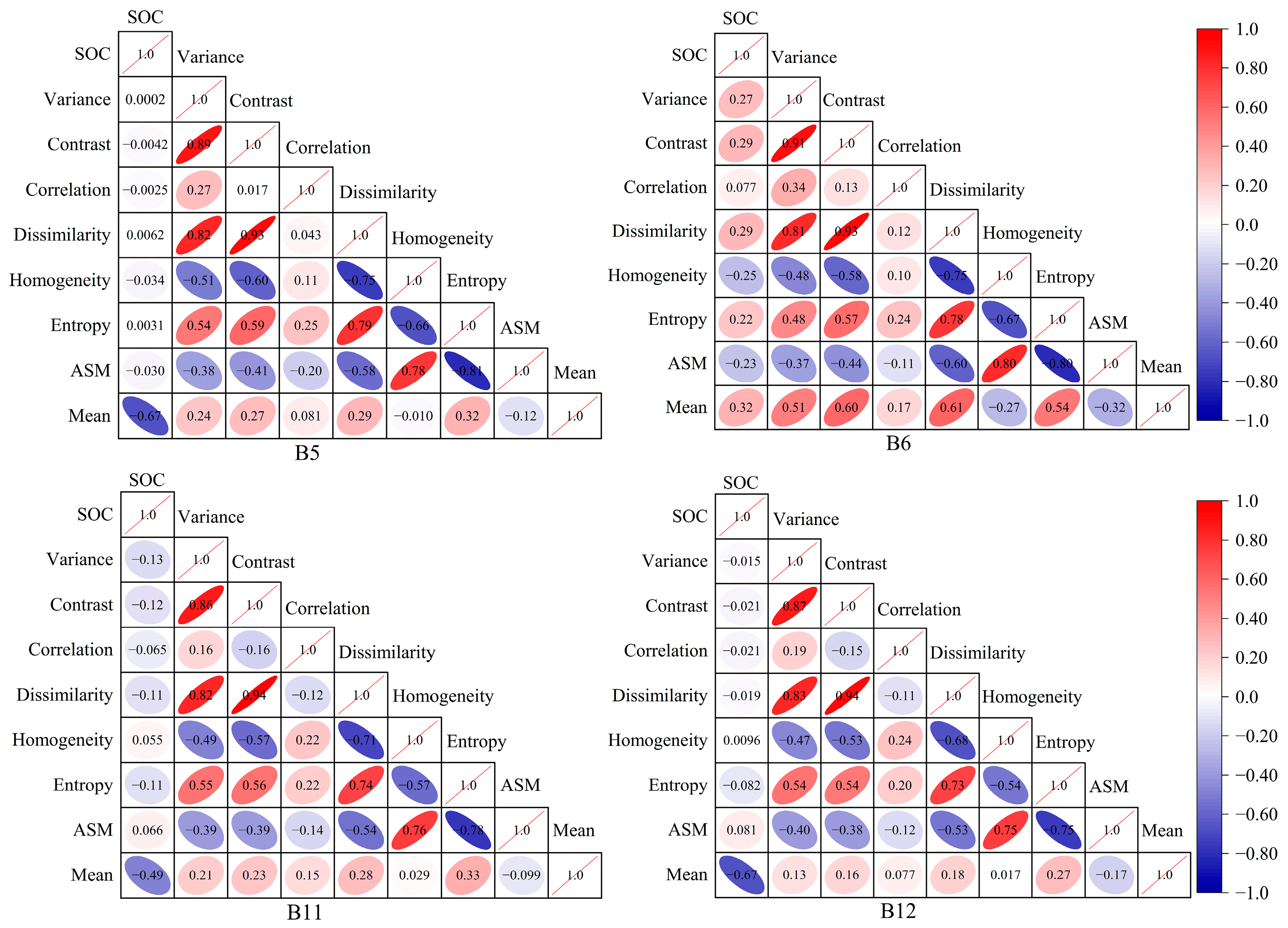
References
- Padarian, J.; Stockmann, U.; Minasny, B.; McBratney, A.B. Monitoring Changes in Global Soil Organic Carbon Stocks from Space. Remote Sens. Environ. 2022, 281, 113260. [Google Scholar] [CrossRef]
- Ugbemuna Ugbaje, S.; Karunaratne, S.; Bishop, T.; Gregory, L.; Searle, R.; Coelli, K.; Farrell, M. Space-Time Mapping of Soil Organic Carbon Stock and Its Local Drivers: Potential for Use in Carbon Accounting. Geoderma 2024, 441, 116771. [Google Scholar] [CrossRef]
- Díaz-Martínez, P.; Maestre, F.T.; Moreno-Jiménez, E.; Delgado-Baquerizo, M.; Eldridge, D.J.; Saiz, H.; Gross, N.; Le Bagousse-Pinguet, Y.; Gozalo, B.; Ochoa, V.; et al. Vulnerability of Mineral-Associated Soil Organic Carbon to Climate across Global Drylands. Nat. Clim. Change 2024, 14, 976–982. [Google Scholar] [CrossRef]
- Peng, J.; Biswas, A.; Jiang, Q.; Zhao, R.; Hu, J.; Hu, B.; Shi, Z. Estimating Soil Salinity from Remote Sensing and Terrain Data in Southern Xinjiang Province, China. Geoderma 2019, 337, 1309–1319. [Google Scholar] [CrossRef]
- Ren, Z.; Li, C.; Fu, B.; Wang, S.; Stringer, L.C. Effects of Aridification on Soil Total Carbon Pools in China’s Drylands. Glob. Change Biol. 2023, 30, e17091. [Google Scholar] [CrossRef]
- Huang, H.; Yang, L.; Zhang, L.; Pu, Y.; Yang, C.; Wu, Q.; Cai, Y.; Shen, F.; Zhou, C. A Review on Digital Mapping of Soil Carbon in Cropland: Progress, Challenge, and Prospect. Environ. Res. Lett. 2022, 17, 123004. [Google Scholar] [CrossRef]
- Kang, Y.; Li, X.; Mao, D.; Wang, Z.; Liang, M. Combining Artificial Neural Network and Ordinary Kriging to Predict Wetland Soil Organic Carbon Concentration in China’s Liao River Basin. Sensors 2020, 20, 7005. [Google Scholar] [CrossRef]
- Xie, B.; Ding, J.; Ge, X.; Li, X.; Han, L.; Wang, Z. Estimation of Soil Organic Carbon Content in the Ebinur Lake Wetland, Xinjiang, China, Based on Multisource Remote Sensing Data and Ensemble Learning Algorithms. Sensors 2022, 22, 2685. [Google Scholar] [CrossRef]
- Vazirani, H.; Wu, X.; Srivastava, A.; Dhar, D.; Pathak, D. Highly Efficient JR Optimization Technique for Solving Prediction Problem of Soil Organic Carbon on Large Scale. Sensors 2024, 24, 7317. [Google Scholar] [CrossRef]
- Pouladi, N.; Gholizadeh, A.; Khosravi, V.; Borůvka, L. Digital Mapping of Soil Organic Carbon Using Remote Sensing Data: A Systematic Review. Catena 2023, 232, 107409. [Google Scholar] [CrossRef]
- Xiang, X.; Du, J.; Jacinthe, P.A.; Zhao, B.; Zhou, H.; Liu, H.; Song, K. Integration of Tillage Indices and Textural Features of Sentinel-2A Multispectral Images for Maize Residue Cover Estimation. Soil Tillage Res. 2022, 221, 105405. [Google Scholar] [CrossRef]
- Vaudour, E.; Gholizadeh, A.; Castaldi, F.; Saberioon, M.; Borůvka, L.; Urbina-Salazar, D.; Fouad, Y.; Arrouays, D.; Richer-de-Forges, A.C.; Biney, J.; et al. Satellite Imagery to Map Topsoil Organic Carbon Content over Cultivated Areas: An Overview. Remote Sens. 2022, 14, 2917. [Google Scholar] [CrossRef]
- Shi, P.; Six, J.; Sila, A.; Vanlauwe, B.; Van Oost, K. Towards Spatially Continuous Mapping of Soil Organic Carbon in Croplands Using Multitemporal Sentinel-2 Remote Sensing. ISPRS J. Photogramm. Remote Sens. 2022, 193, 187–199. [Google Scholar] [CrossRef]
- Vaudour, E.; Gomez, C.; Lagacherie, P.; Loiseau, T.; Baghdadi, N.; Urbina-Salazar, D.; Loubet, B.; Arrouays, D. Temporal Mosaicking Approaches of Sentinel-2 Images for Extending Topsoil Organic Carbon Content Mapping in Croplands. Int. J. Appl. Earth Obs. Geoinf. 2021, 96, 102277. [Google Scholar] [CrossRef]
- Vanongeval, F.; Van Orshoven, J.; Gobin, A. Contribution of Sentinel-2 Spring Seedbed Spectra to the Digital Mapping of Soil Organic Carbon Concentration. Geoderma 2024, 449, 116984. [Google Scholar] [CrossRef]
- Guo, B.; Yang, X.; Yang, M.; Sun, D.; Zhu, W.; Zhu, D.; Wang, J. Mapping Soil Salinity Using a Combination of Vegetation Index Time Series and Single-Temporal Remote Sensing Images in the Yellow River Delta, China. Catena 2023, 231, 107313. [Google Scholar] [CrossRef]
- Wang, J.; Feng, C.; Hu, B.; Chen, S.; Hong, Y.; Arrouays, D.; Peng, J.; Shi, Z. A Novel Framework for Improving Soil Organic Matter Prediction Accuracy in Cropland by Integrating Soil, Vegetation and Human Activity Information. Sci. Total Environ. 2023, 903, 166112. [Google Scholar] [CrossRef]
- He, X.; Yang, L.; Li, A.; Zhang, L.; Shen, F.; Cai, Y.; Zhou, C. Soil Organic Carbon Prediction Using Phenological Parameters and Remote Sensing Variables Generated from Sentinel-2 Images. Catena 2021, 205, 105442. [Google Scholar] [CrossRef]
- Castaldi, F.; Halil Koparan, M.; Wetterlind, J.; Žydelis, R.; Vinci, I.; Özge Savaş, A.; Kıvrak, C.; Tunçay, T.; Volungevičius, J.; Obber, S.; et al. Assessing the Capability of Sentinel-2 Time-Series to Estimate Soil Organic Carbon and Clay Content at Local Scale in Croplands. ISPRS J. Photogramm. Remote Sens. 2023, 199, 40–60. [Google Scholar] [CrossRef]
- Yang, H.; Wang, Z.; Cao, J.; Wu, Q.; Zhang, B. Estimating Soil Salinity Using Gaofen-2 Imagery: A Novel Application of Combined Spectral and Textural Features. Environ. Res. 2023, 217, 114870. [Google Scholar] [CrossRef]
- Cao, X.; Chen, W.; Ge, X.; Chen, X.; Wang, J.; Ding, J. Multidimensional Soil Salinity Data Mining and Evaluation from Different Satellites. Sci. Total Environ. 2022, 846, 157416. [Google Scholar] [CrossRef] [PubMed]
- Duan, M.; Song, X.; Liu, X.; Cui, D.; Zhang, X. Mapping the Soil Types Combining Multi-Temporal Remote Sensing Data with Texture Features. Comput. Electron. Agric. 2022, 200, 107230. [Google Scholar] [CrossRef]
- Duan, M.; Song, X.; Li, Z.; Zhang, X.; Ding, X.; Cui, D. Identifying Soil Groups and Selecting a High-Accuracy Classification Method Based on Multi-Textural Features with Optimal Window Sizes Using Remote Sensing Images. Ecol. Inform. 2024, 81, 102563. [Google Scholar] [CrossRef]
- Lamichhane, S.; Kumar, L.; Wilson, B. Digital Soil Mapping Algorithms and Covariates for Soil Organic Carbon Mapping and Their Implications: A Review. Geoderma 2019, 352, 395–413. [Google Scholar] [CrossRef]
- Chen, S.; Arrouays, D.; Leatitia Mulder, V.; Poggio, L.; Minasny, B.; Roudier, P.; Libohova, Z.; Lagacherie, P.; Shi, Z.; Hannam, J.; et al. Digital Mapping of GlobalSoilMap Soil Properties at a Broad Scale: A Review. Geoderma 2022, 409, 115567. [Google Scholar] [CrossRef]
- Sun, Y.; Ma, J.; Zhao, W.; Qu, Y.; Gou, Z.; Chen, H.; Tian, Y.; Wu, F. Digital Mapping of Soil Organic Carbon Density in China Using an Ensemble Model. Environ. Res. 2023, 231, 116131. [Google Scholar] [CrossRef]
- Hu, B.; Xie, M.; Zhou, Y.; Chen, S.; Zhou, Y.; Ni, H.; Peng, J.; Ji, W.; Hong, Y.; Li, H.; et al. A High-Resolution Map of Soil Organic Carbon in Cropland of Southern China. Catena 2024, 237, 107813. [Google Scholar] [CrossRef]
- Tajik, S.; Ayoubi, S.; Zeraatpisheh, M. Digital Mapping of Soil Organic Carbon Using Ensemble Learning Model in Mollisols of Hyrcanian Forests, Northern Iran. Geoderma Reg. 2020, 20, e00256. [Google Scholar] [CrossRef]
- Li, Z.; Liu, F.; Peng, X.; Hu, B.; Song, X. Synergetic Use of DEM Derivatives, Sentinel-1 and Sentinel-2 Data for Mapping Soil Properties of a Sloped Cropland Based on a Two-Step Ensemble Learning Method. Sci. Total Environ. 2023, 866, 161421. [Google Scholar] [CrossRef]
- Tao, S.; Zhang, X.; Feng, R.; Qi, W.; Wang, Y.; Shrestha, B. Retrieving Soil Moisture from Grape Growing Areas Using Multi-Feature and Stacking-Based Ensemble Learning Modeling. Comput. Electron. Agric. 2023, 204, 107537. [Google Scholar] [CrossRef]
- Dvorakova, K.; Heiden, U.; Pepers, K.; Staats, G.; van Os, G.; van Wesemael, B. Improving Soil Organic Carbon Predictions from a Sentinel–2 Soil Composite by Assessing Surface Conditions and Uncertainties. Geoderma 2023, 429, 116128. [Google Scholar] [CrossRef]
- Luo, C.; Zhang, W.; Zhang, X.; Liu, H. Mapping of Soil Organic Matter in a Typical Black Soil Area Using Landsat-8 Synthetic Images at Different Time Periods. Catena 2023, 231, 107336. [Google Scholar] [CrossRef]
- Zhang, T.T.; Qi, J.G.; Gao, Y.; Ouyang, Z.T.; Zeng, S.L.; Zhao, B. Detecting Soil Salinity with MODIS Time Series VI Data. Ecol. Indic. 2015, 52, 480–489. [Google Scholar] [CrossRef]
- Zhou, T.; Geng, Y.; Lv, W.; Xiao, S.; Zhang, P.; Xu, X.; Chen, J.; Wu, Z.; Pan, J.; Si, B.; et al. Effects of Optical and Radar Satellite Observations within Google Earth Engine on Soil Organic Carbon Prediction Models in Spain. J. Environ. Manage. 2023, 338, 117810. [Google Scholar] [CrossRef]
- Yang, R.M.; Guo, W.W. Modelling of Soil Organic Carbon and Bulk Density in Invaded Coastal Wetlands Using Sentinel-1 Imagery. Int. J. Appl. Earth Obs. Geoinf. 2019, 82, 101906. [Google Scholar] [CrossRef]
- Zhang, L.; Cai, Y.; Huang, H.; Li, A.; Yang, L.; Zhou, C. A CNN-LSTM Model for Soil Organic Carbon Content Prediction with Long Time Series of MODIS-Based Phenological Variables. Remote Sens. 2022, 14, 4441. [Google Scholar] [CrossRef]
- Luo, C.; Zhang, X.; Wang, Y.; Men, Z.; Liu, H. Regional Soil Organic Matter Mapping Models Based on the Optimal Time Window, Feature Selection Algorithm and Google Earth Engine. Soil Tillage Res. 2022, 219, 105325. [Google Scholar] [CrossRef]
- Liu, Y.; Fan, Y.; Feng, H.; Chen, R.; Bian, M.; Ma, Y.; Yue, J.; Yang, G. Estimating Potato Above-Ground Biomass Based on Vegetation Indices and Texture Features Constructed from Sensitive Bands of UAV Hyperspectral Imagery. Comput. Electron. Agric. 2024, 220, 108918. [Google Scholar] [CrossRef]
- Chen, Z.; Xue, J.; Wang, Z.; Zhou, Y.; Deng, X.; Liu, F.; Song, X.; Zhang, G.; Su, Y.; Zhu, P.; et al. Ensemble Modelling-Based Pedotransfer Functions for Predicting Soil Bulk Density in China. Geoderma 2024, 448, 116969. [Google Scholar] [CrossRef]
- Swain, S.R.; Chakraborty, P.; Panigrahi, N.; Vasava, H.B.; Reddy, N.N.; Roy, S.; Majeed, I.; Das, B.S. Estimation of Soil Texture Using Sentinel-2 Multispectral Imaging Data: An Ensemble Modeling Approach. Soil Tillage Res. 2021, 213, 105134. [Google Scholar] [CrossRef]
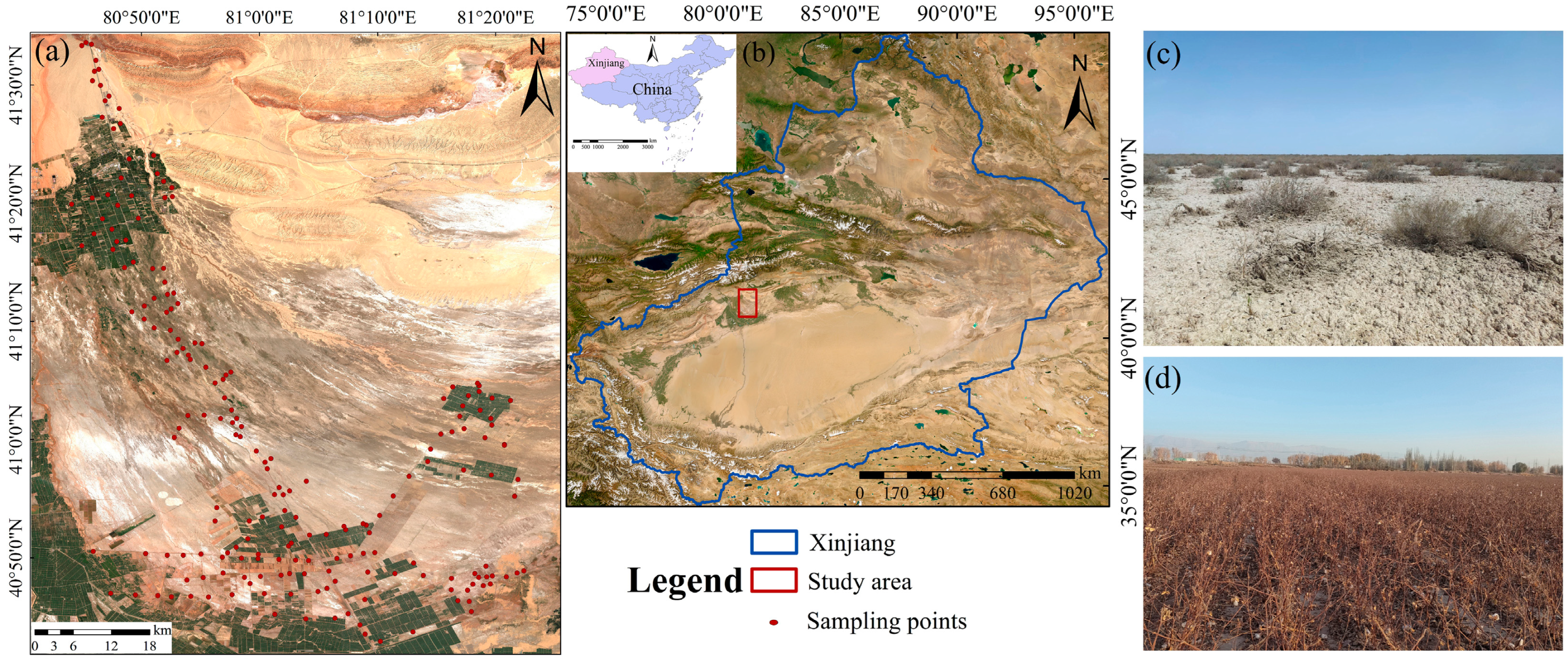

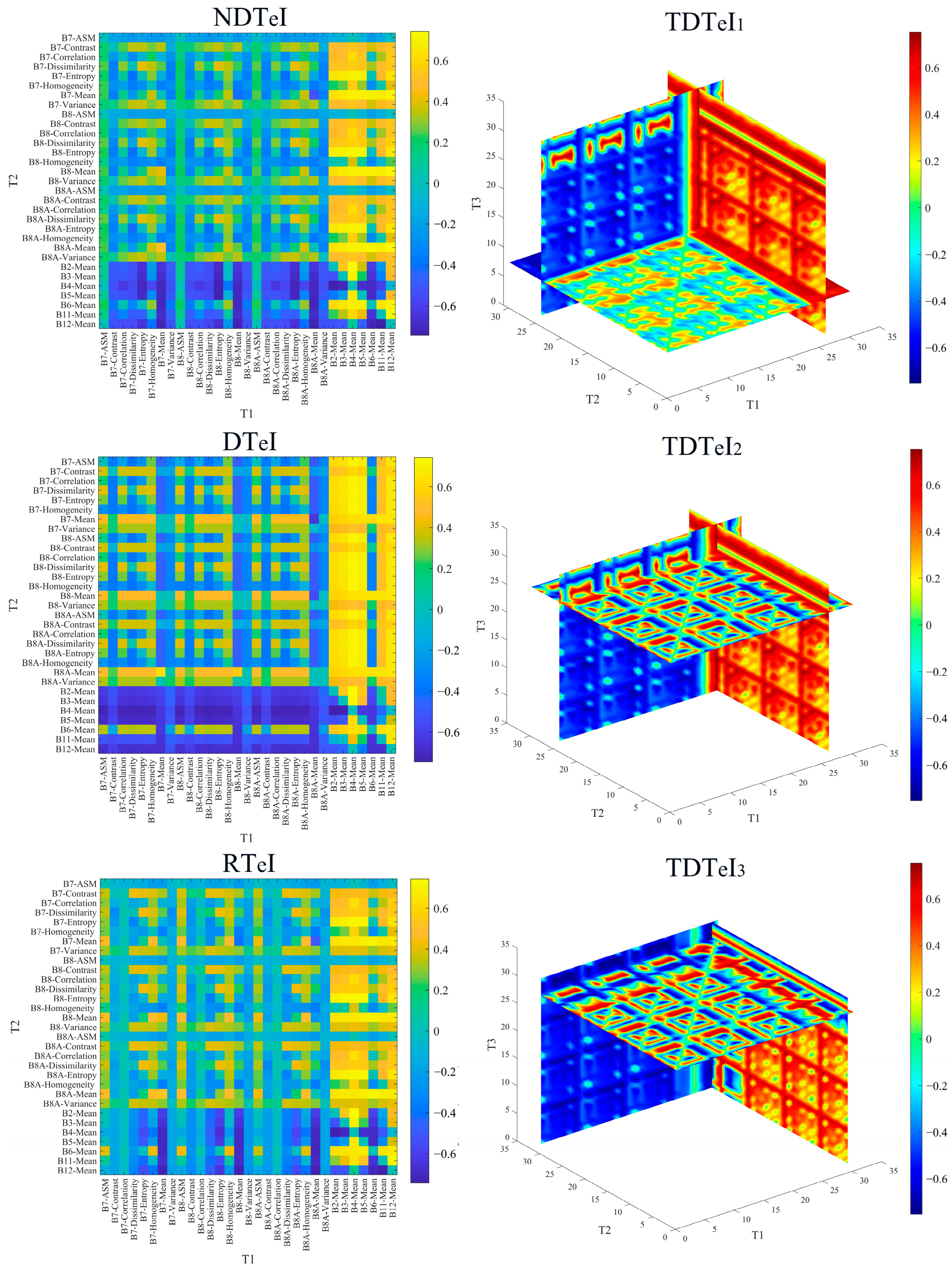
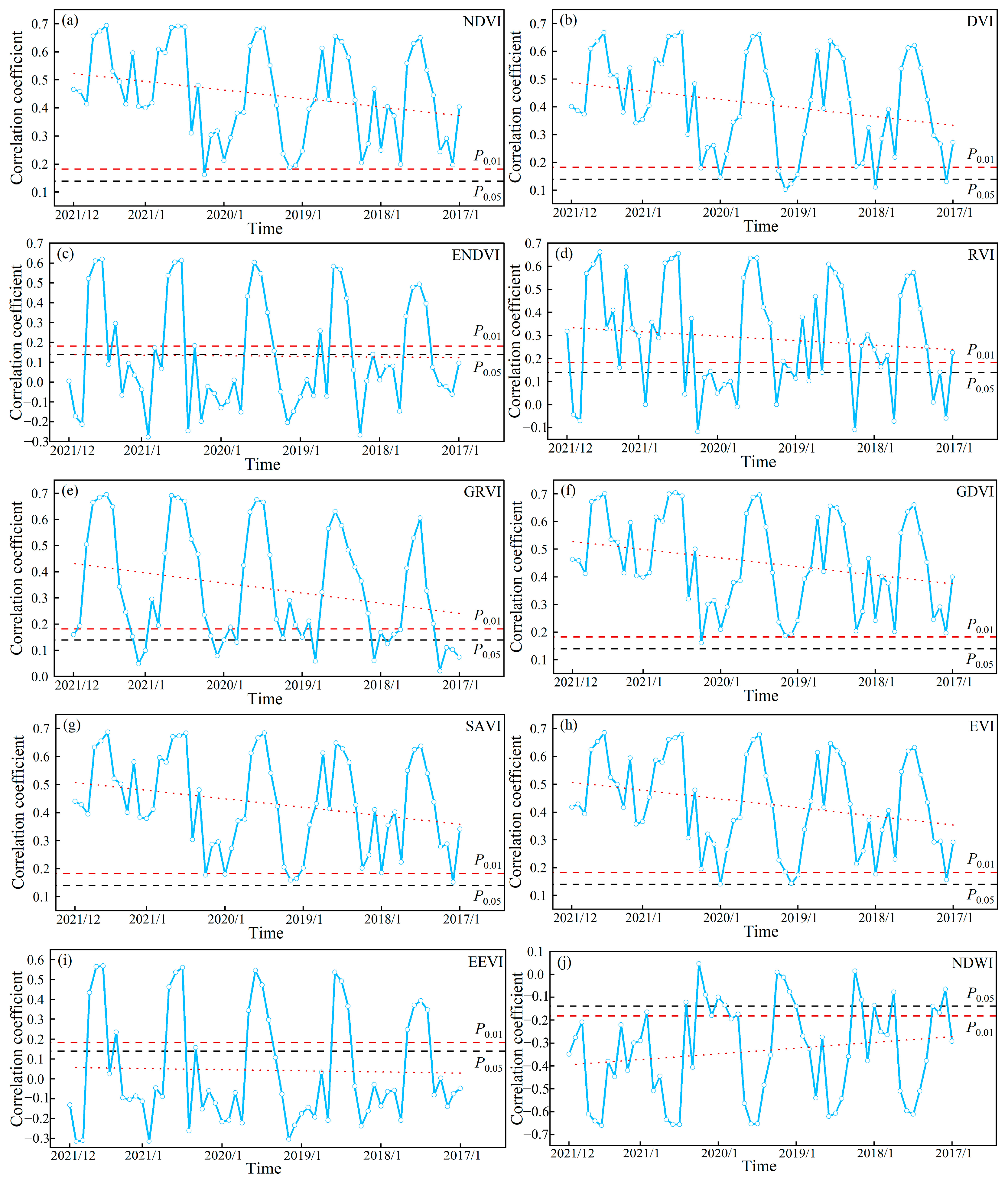
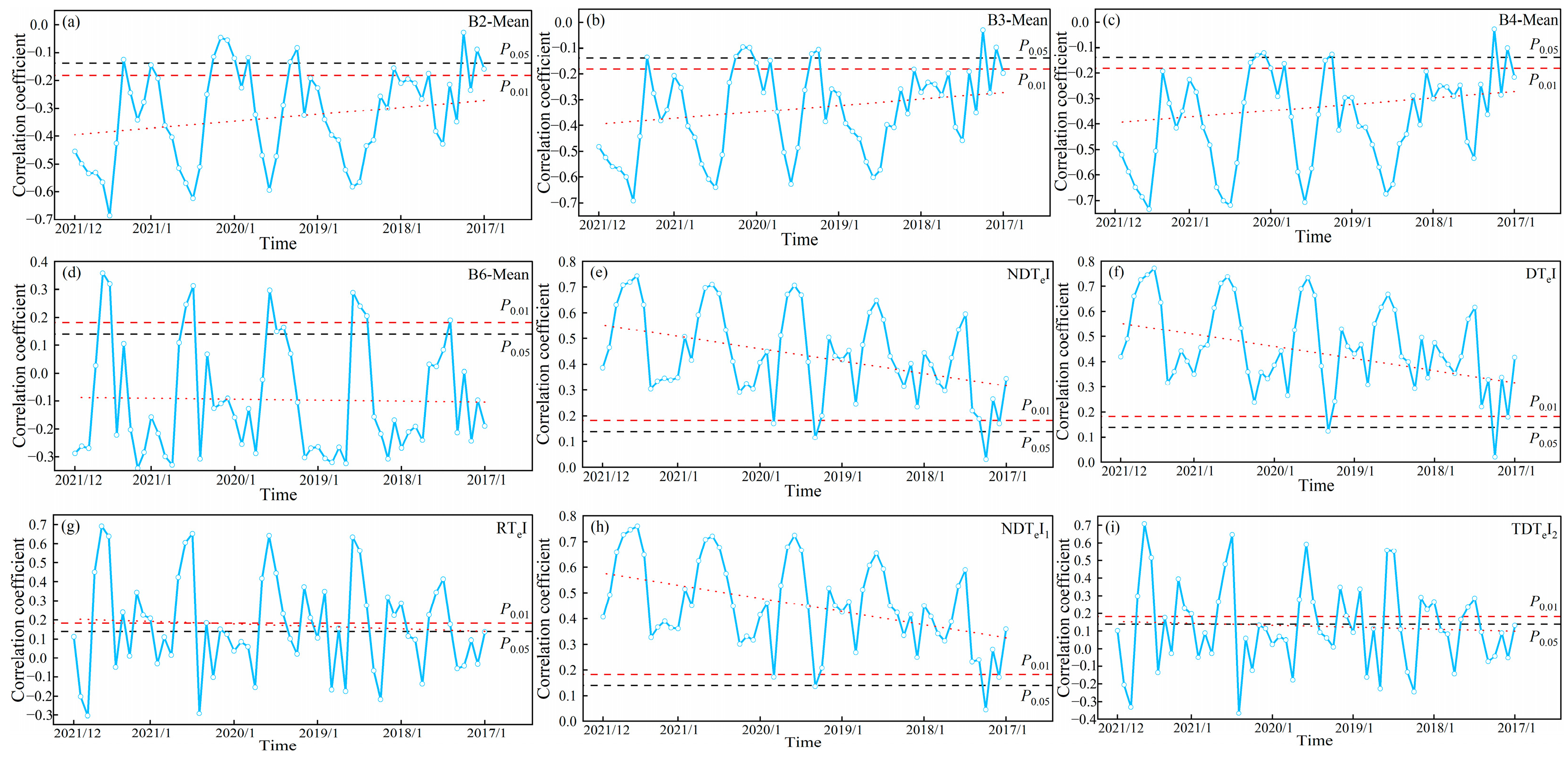
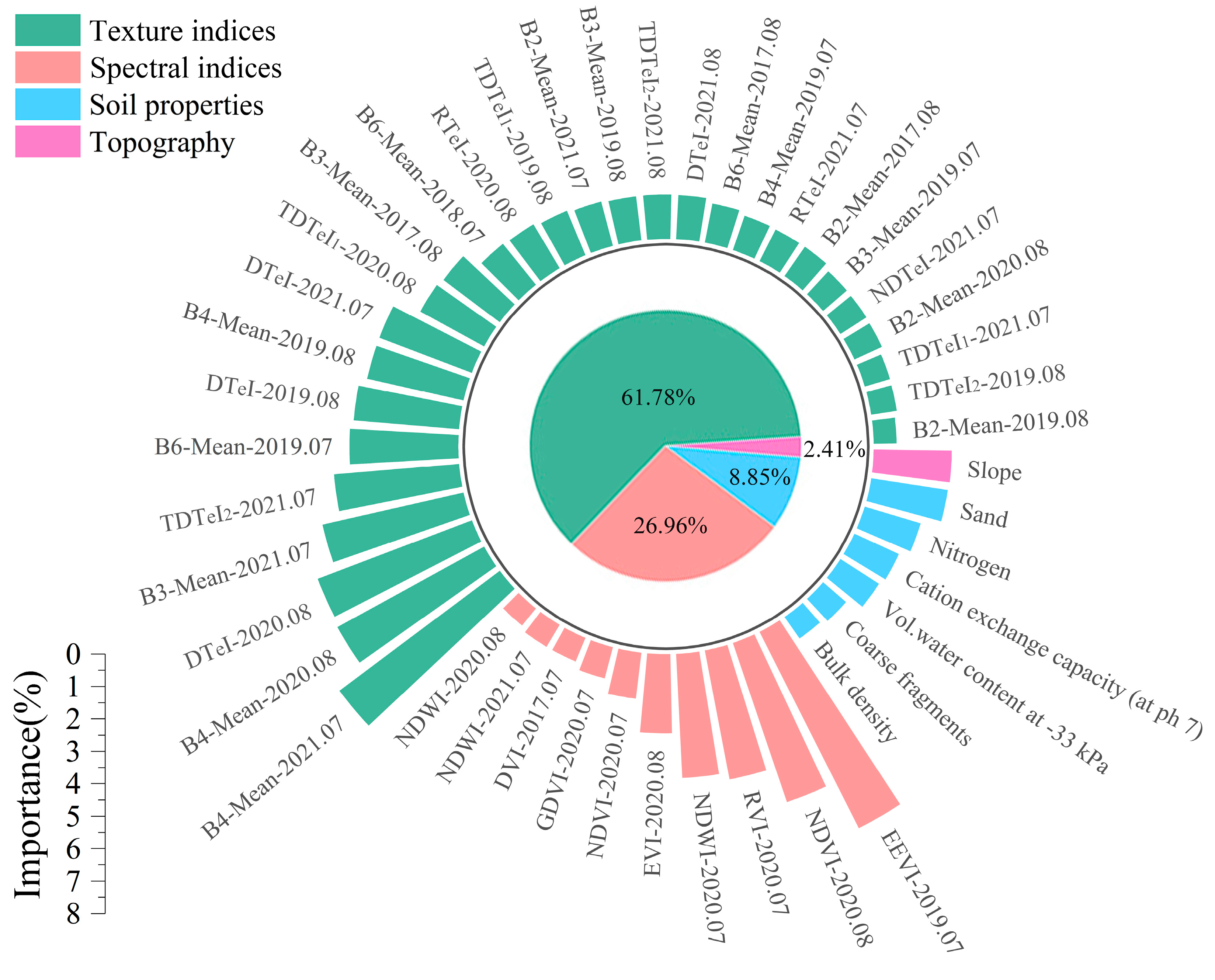
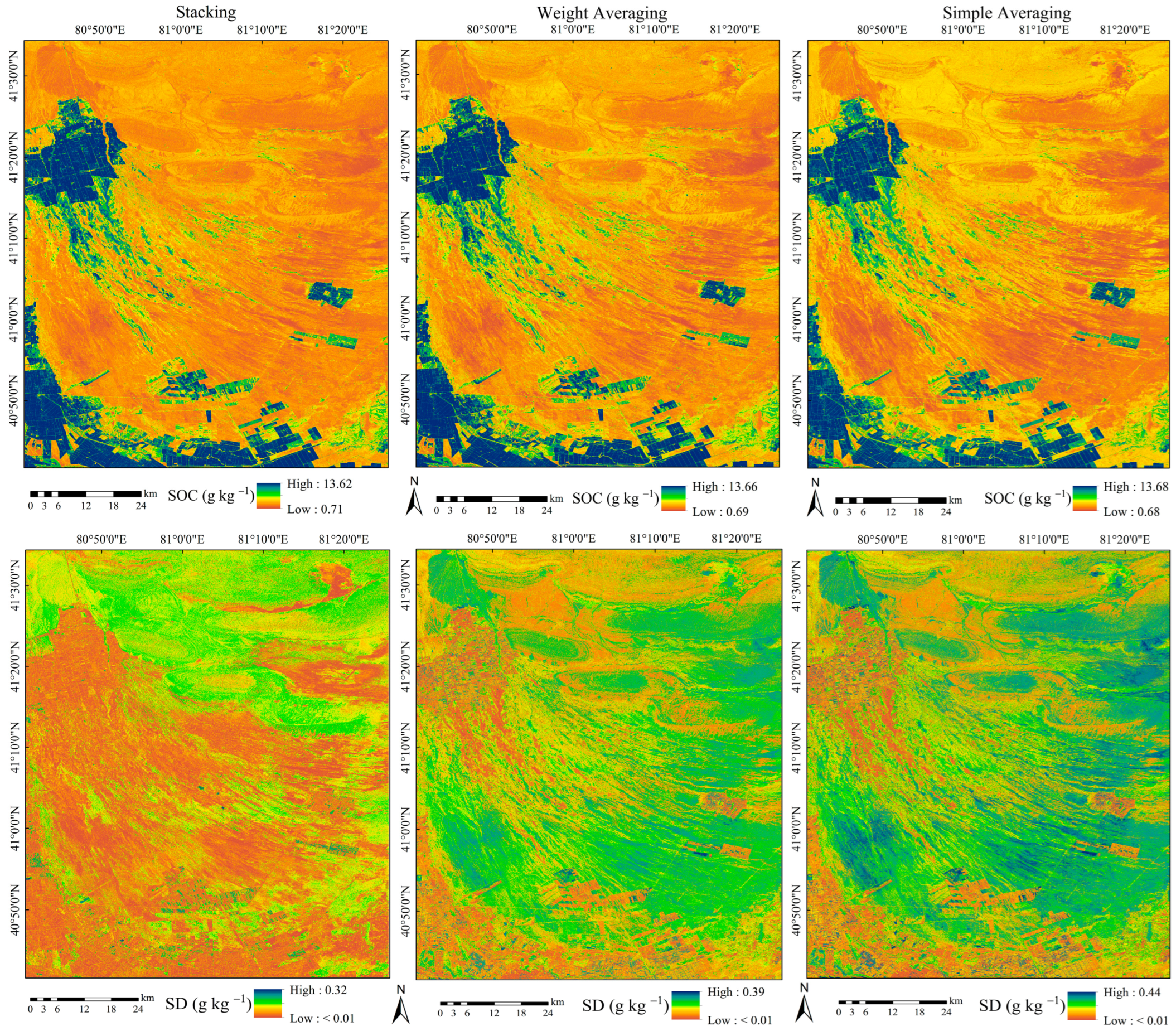

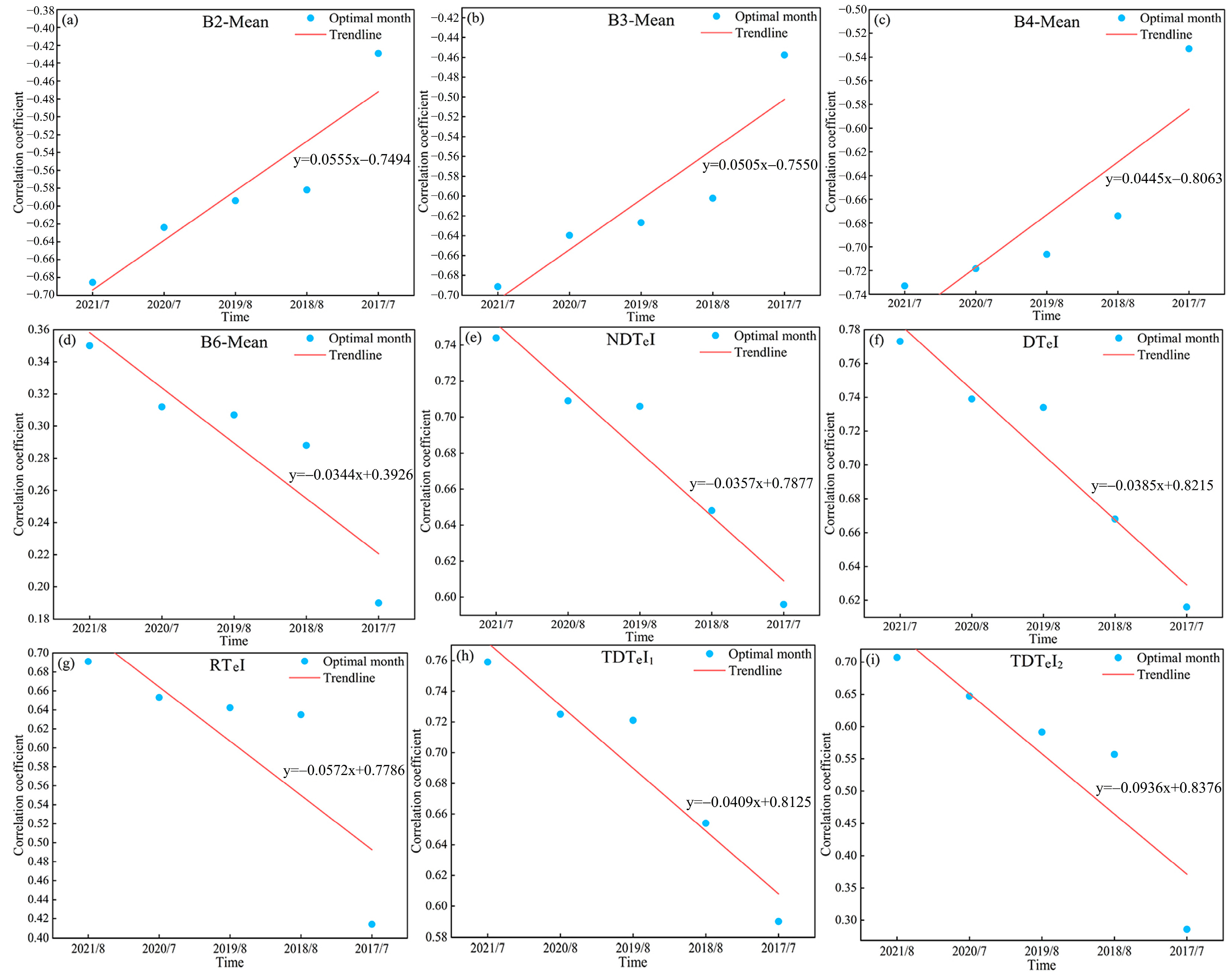
| Variable Categories | Variables | Sources |
|---|---|---|
| Topographic variables | Elevation | (https://earthdata.nasa.gov/) (accessed on 10 May 2024) |
| Longitudinal curvature | ||
| Aspect | ||
| Valley depth | ||
| Slope | ||
| Curvature | ||
| Flow direction | ||
| Topographic wetness index | ||
| Convergence index | ||
| Channel network base level | ||
| Vol. water content at −33 kPa | ||
| Soil properties | Nitrogen | (https://soilgrids.org) (accessed on 24 May 2024) |
| Coarse fragments | ||
| Sand | ||
| Silt | ||
| Vol. water content at −10 kPa | ||
| Clay | ||
| Cation exchange capacity (at pH 7) | ||
| pH water | ||
| Bulk density | ||
| Vol. water content at −1500 kPa |
| Variables | Predictors | Acronyms | Formulas | Reference |
|---|---|---|---|---|
| Spectral indices | Normalized Difference Vegetation Index | NDVI | [16] | |
| Difference Vegetation Index | DVI | [16] | ||
| Enhanced Normalized Difference Vegetation Index | ENDVI | [16] | ||
| Ratio Vegetation Index | RVI | [16] | ||
| Green-Red Vegetation Index | GRVI | [16] | ||
| Generalized Difference Vegetation Index | GDVI | [16] | ||
| Soil-Adjusted Vegetation Index | SAVI | [16] | ||
| Enhanced Vegetation Index | EVI | [16] | ||
| Enhanced Environment Vegetation Index | EEVI | [16] | ||
| Normalized Difference Water Index | NDWI | [16] | ||
| Texture indices | Angular Second Moment | ASM | [11] | |
| Contrast | CON | [11] | ||
| Correlation | COR | [11] | ||
| Dissimilarity | DIS | [11] | ||
| Homogeneity | HOM | [11] | ||
| Entropy | ENT | [11] | ||
| Variance | VAR | [11] | ||
| Mean | MEA | [11] | ||
| Difference Texture Index | DTeI | this study | ||
| Normalized Difference Texture Index | NDTeI | this study | ||
| Ratio Texture Index | RTeI | this study | ||
| Three-Dimensional Texture Index 1 | TDTeI1 | this study | ||
| Three-Dimensional Texture Index 2 | TDTeI2 | this study | ||
| Three-Dimensional Texture Index 3 | TDTeI3 | this study |
| Scenarios | Variables |
|---|---|
| Scenario A | Spectral indices + Topographic |
| Scenario B | Spectral indices + Topographic + Soil properties |
| Scenario C | Spectral indices + Topographic + Texture indices |
| Scenario D | Spectral indices + Topographic + Soil properties + Texture indices |
| Base Learners | Parameters Type (Range [Start, Stop, Step]) |
|---|---|
| MLP | hidden_layer_sizes [(50), (100), (50, 50), (100, 50), (50, 100)], learning_rate [0.01, 0.1, 0.01], solver: [ Adam], activation: [relu] |
| GBRT | min_samples_leaf [1, 10, 1], n_estimators [10, 500, 10], max_depth [1, 10, 1], learning_rate [0.01, 1, 0.01], min_samples_split [1, 10, 1] |
| RF | min_samples_split [1, 10, 1], max_depth [1, 10, 1], n_estimators [10, 500, 10], min_samples_leaf [1, 10, 1] |
| XGBoost | learning_rate [0.01, 0.1, 0.01], max_depth [1, 10, 1], n_estimators [10, 500, 10] |
| PLSR | n_components [1, 50, 1] |
| Scenario | Stacking | Weight Averaging | Simple Averaging | ||||||
|---|---|---|---|---|---|---|---|---|---|
| Type of Scenario | R2 | MAE | RMSE | R2 | MAE | RMSE | R2 | MAE | RMSE |
| Scenario A | 0.82 | 1.04 | 1.28 | 0.81 | 1.07 | 1.31 | 0.80 | 1.10 | 1.34 |
| Scenario B | 0.84 | 0.98 | 1.20 | 0.83 | 1.01 | 1.24 | 0.82 | 1.04 | 1.27 |
| Scenario C | 0.87 | 0.92 | 1.14 | 0.85 | 0.95 | 1.18 | 0.84 | 0.98 | 1.21 |
| Scenario D | 0.89 | 0.86 | 1.09 | 0.87 | 0.89 | 1.12 | 0.86 | 0.92 | 1.15 |
Disclaimer/Publisher’s Note: The statements, opinions and data contained in all publications are solely those of the individual author(s) and contributor(s) and not of MDPI and/or the editor(s). MDPI and/or the editor(s) disclaim responsibility for any injury to people or property resulting from any ideas, methods, instructions or products referred to in the content. |
© 2025 by the authors. Licensee MDPI, Basel, Switzerland. This article is an open access article distributed under the terms and conditions of the Creative Commons Attribution (CC BY) license (https://creativecommons.org/licenses/by/4.0/).
Share and Cite
Cui, Z.; Chen, S.; Hu, B.; Wang, N.; Feng, C.; Peng, J. Mapping Soil Organic Carbon by Integrating Time-Series Sentinel-2 Data, Environmental Covariates and Multiple Ensemble Models. Sensors 2025, 25, 2184. https://doi.org/10.3390/s25072184
Cui Z, Chen S, Hu B, Wang N, Feng C, Peng J. Mapping Soil Organic Carbon by Integrating Time-Series Sentinel-2 Data, Environmental Covariates and Multiple Ensemble Models. Sensors. 2025; 25(7):2184. https://doi.org/10.3390/s25072184
Chicago/Turabian StyleCui, Zhibo, Songchao Chen, Bifeng Hu, Nan Wang, Chunhui Feng, and Jie Peng. 2025. "Mapping Soil Organic Carbon by Integrating Time-Series Sentinel-2 Data, Environmental Covariates and Multiple Ensemble Models" Sensors 25, no. 7: 2184. https://doi.org/10.3390/s25072184
APA StyleCui, Z., Chen, S., Hu, B., Wang, N., Feng, C., & Peng, J. (2025). Mapping Soil Organic Carbon by Integrating Time-Series Sentinel-2 Data, Environmental Covariates and Multiple Ensemble Models. Sensors, 25(7), 2184. https://doi.org/10.3390/s25072184










